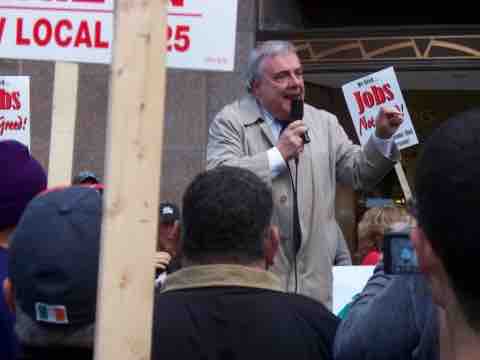Human resource professionals deal with the employees of an organization and, therefore, the unions as well. Unions, as groups of employees interested in bargaining for specific rights and/or contractual benefits, are the responsibility of human resource professionals. Just as individual employees negotiate with human resources, so too do groups of employees.
Forming a Union
A labor union is an organization of workers who have banded together to achieve common goals. The current method for workers to form a union in a particular workplace in the United States is a sign-up followed by an election process. At least 30% of employees must sign petition cards requesting a union. The petition cards must then be submitted to the National Labor Relations Board (NLRB), which verifies them and orders a secret-ballot election to elect union representatives.

Unionization
Unions mobilize workers to achieve shared goals.
Two exceptions exist. If over 50% of the employees sign an authorization card requesting a union, the employer can voluntarily choose to waive the secret-ballot election process and just recognize the union. The other exception is a last resort—it allows the NLRB to order an employer to recognize a union if over 50% have signed cards and the employer has engaged in unfair labor practices, making a fair election unlikely.
The Function of a Union
The labor union, through its leadership, bargains with the employer on behalf of union members and negotiates labor contracts (collective bargaining) with employers. The most common purpose of unions is to defend conditions of employment that benefit their members or negotiate for better conditions. This may include negotiating the terms of the following:
- Wages
- Work rules
- Complaint procedures
- Rules governing hiring
- Firing and promotion of workers
- Benefits
- Workplace safety and policies
The agreements negotiated by the union leaders are binding on the union members and the employer, as well as, in some cases, non-member workers.
Union Activities
Aside from collective bargaining, union activities vary, but may include the following:
- Provision of benefits to members—the provision of professional training, legal advice, and representation for members is a benefit of union membership.
- Industrial action—unions may enforce strikes or resistance to lockouts to further members' goals.
- Political activity—unions may promote legislation favorable to their members or to workers as a whole. To this end they may pursue campaigns, undertake lobbying, and financially support individual candidates or parties for public office.
Organizational Structures of Unions
Unions may organize a particular section of skilled workers, a cross-section of workers from various trades, or all workers within a particular industry. These unions are often divided into locals and united in national federations. These federations themselves sometimes affiliate with internationals, such as the International Trade Union Confederation.